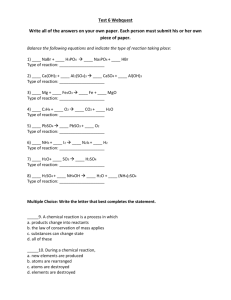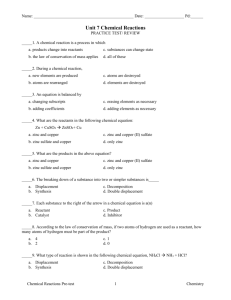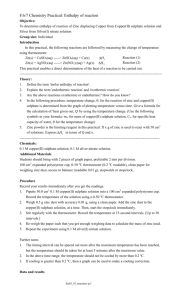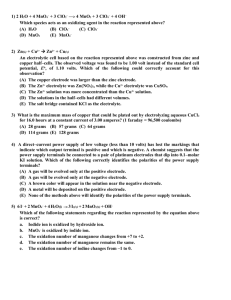STEM ED/CHM Nanotechnology at UMass Amherst
advertisement
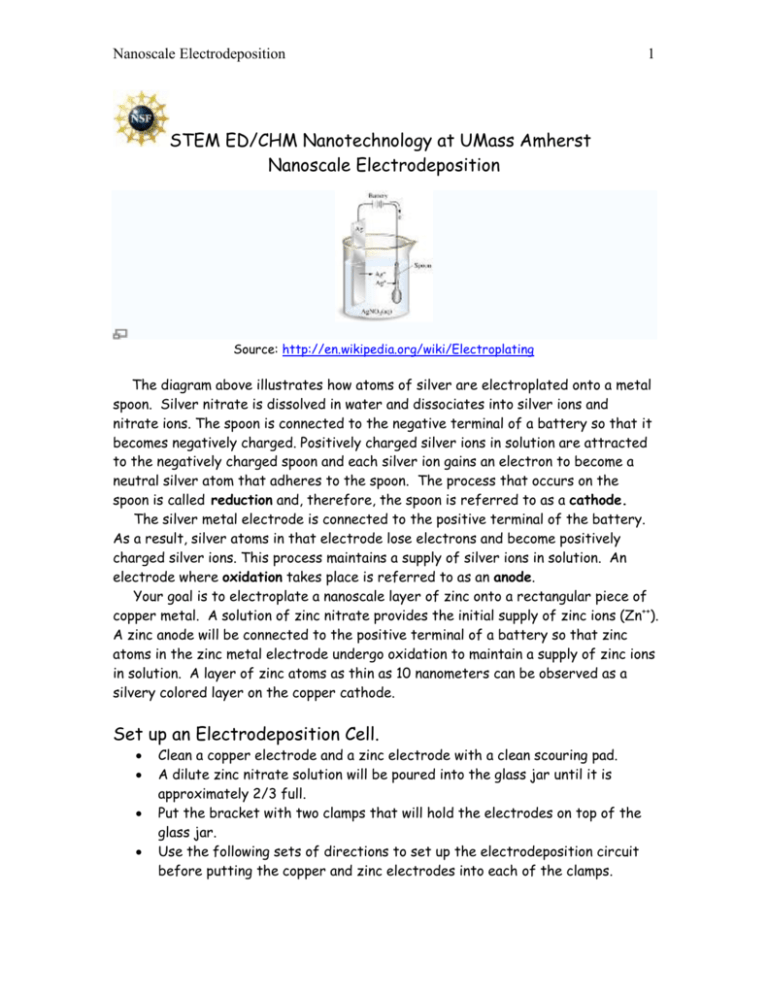
Nanoscale Electrodeposition 1 STEM ED/CHM Nanotechnology at UMass Amherst Nanoscale Electrodeposition Source: http://en.wikipedia.org/wiki/Electroplating The diagram above illustrates how atoms of silver are electroplated onto a metal spoon. Silver nitrate is dissolved in water and dissociates into silver ions and nitrate ions. The spoon is connected to the negative terminal of a battery so that it becomes negatively charged. Positively charged silver ions in solution are attracted to the negatively charged spoon and each silver ion gains an electron to become a neutral silver atom that adheres to the spoon. The process that occurs on the spoon is called reduction and, therefore, the spoon is referred to as a cathode. The silver metal electrode is connected to the positive terminal of the battery. As a result, silver atoms in that electrode lose electrons and become positively charged silver ions. This process maintains a supply of silver ions in solution. An electrode where oxidation takes place is referred to as an anode. Your goal is to electroplate a nanoscale layer of zinc onto a rectangular piece of copper metal. A solution of zinc nitrate provides the initial supply of zinc ions (Zn++). A zinc anode will be connected to the positive terminal of a battery so that zinc atoms in the zinc metal electrode undergo oxidation to maintain a supply of zinc ions in solution. A layer of zinc atoms as thin as 10 nanometers can be observed as a silvery colored layer on the copper cathode. Set up an Electrodeposition Cell. Clean a copper electrode and a zinc electrode with a clean scouring pad. A dilute zinc nitrate solution will be poured into the glass jar until it is approximately 2/3 full. Put the bracket with two clamps that will hold the electrodes on top of the glass jar. Use the following sets of directions to set up the electrodeposition circuit before putting the copper and zinc electrodes into each of the clamps. Nanoscale Electrodeposition 2 Set up a Series Circuit Sample Circuit Diagram An on/off switch, a cell battery holder, ammeter, and lead wires are provided. Digital multimeters can measure the electric current. Use a red wire with an alligator clip and banana plug to connect the top of the zinc electrode to the positive terminal of the switch (the red terminal). Make sure that the switch is in the off position (the side of the button with the zero). Use a red wire with banana plugs at both ends to connect the negative terminal of the switch (the black terminal) to the positive terminal of the battery holder (the red terminal). Use a red wire with banana plugs at both ends to connect the negative terminal (the black terminal) of the battery holder to the negative terminal of the ammeter (the black terminal). Use a red wire with an alligator clip and a banana plug to connect the 500 milliamperes terminal (a red terminal) to the copper electrode. Move the banana plug to a more sensitive scale if the needle does not move very much. Lower the electrodes into the solution of zinc nitrate and attach them to the clamps. Be prepared to turn off the switch if the needle of the ammeter goes in the wrong direction. Briefly press the switch to on to determine if the series circuit has been set up correctly. Collect and Record Time and Electric Current Data Use Tables #1 and #2 on the worksheet to record data. Be prepared to record time and ammeter data so that you can calculate a value for the average current during the trial. Push the switch to the on position. Record time and ammeter data. Turn the switch off when an observable layer of zinc covers the part of the copper electrode that is in the zinc nitrate solution. Use the worksheet to determine and record the time elapsed during the trial and the average of the electric current data. Nanoscale Electrodeposition 3 Remove and Dry the Electrodes Disconnect the bracket from the electric circuit. Remove the electrodes from the solution and from the bracket. Put the electrodes on dry paper towels. The layer of zinc may be fragile. Determine the length and width of the electroplated area on the copper electrode that was plated with a layer of zinc. If the layer of zinc has time to dry and harden, the layer of zinc can be rubbed to a shine with a paper towel. Calculations You know the average amount of electric current that flowed through the circuit in milliamperes and amperes. One ampere is equal to 6.24 x 1018 electrons per second. You also know how many seconds that the current was flowing. Use Table #3 to record you answer to Calculations #1 and #2. . Calculation #1: Calculate the total number of electrons that flowed through the circuit during the time that the electroplating process took place. Calculation #2: Each zinc ion in solution gained two electrons when it became a neutral zinc atom. (Zn++ + 2e- -> Zno). Calculate how many zinc ions became neutral zinc atoms. Record the remaining calculations on Table #4. Note: The next three steps are similar to determining how many marbles form a layer of marbles on a rectangular surface if you know the diameter of each marble. You also need the following information to do Calculations 3 and 4. The width and the length of the area of the copper electrode that was plated with a layer of zinc atoms. Zinc atoms have a diameter of 3.06 x 10-10 meters. Calculation #3: Calculate the number of atoms of zinc that formed a row across the width of the copper electrode. Calculation #4: Calculate the number of atoms of zinc that formed a column along the length of the copper electrode that was in the solution. Calculation #5: Calculate the number of zinc atoms that form a single layer of zinc atoms on one side of the copper electrode. Calculation #6: Calculate the number of atoms that formed a single layer on both sides of the copper electrode. Nanoscale Electrodeposition 4 Information you need for Calculation #7 the total number of zinc ions that became zinc atoms. the number of zinc atoms that formed just one layer of zinc atoms. Calculation #7: Calculate the number of layers of zinc atoms that were on the copper electrode. Remember that zinc atoms have a diameter of 3.06 x 10-10 meters. Calculation #8: Calculate the average thickness of the layer of zinc on the copper electrode. Question: What was the average thickness of the layer of zinc (expressed in nanometers)? Question: What are some possible sources of error in your team’s calculation of the average thickness of zinc on the copper cathode? Trial Two: Mask a Surface Electron beam lithography (EBL) is a promising nanoscale engineering process. Electron beams moves across a “mask” on the surface of a material. A beam of electrons is delivered to the mask, referred to as a “resist”. The resist is either developed in a chemical bath or the electron beam interacts with the material to remove the resist material. This process results in a patterned “etching of the surface of a material. Masking tape used by painters can be used simulate the EBL process. Replace the zinc nitrate solution in the tumbler. Clean and install new electrodes in the bracket. Use painter’s masking tape to cover a section of a copper electrode so that when the tape is removed a pattern of copper and zinc is created. Repeat the electrodeposition procedure. Optional Trial Predict what will happen to the electrodeposition of zinc onto a copper electrode if you replace the 1.5 volt battery with a 6 volt battery. Turn the on/off switch to the off position. Install the 6 volt battery in the circuit. Set the ammeter to the highest current range. Turn the switch on and adjust the ammeter range as needed. Compare the results with your predicted results. Propose an explanation for the change in the electrodeposition process.




